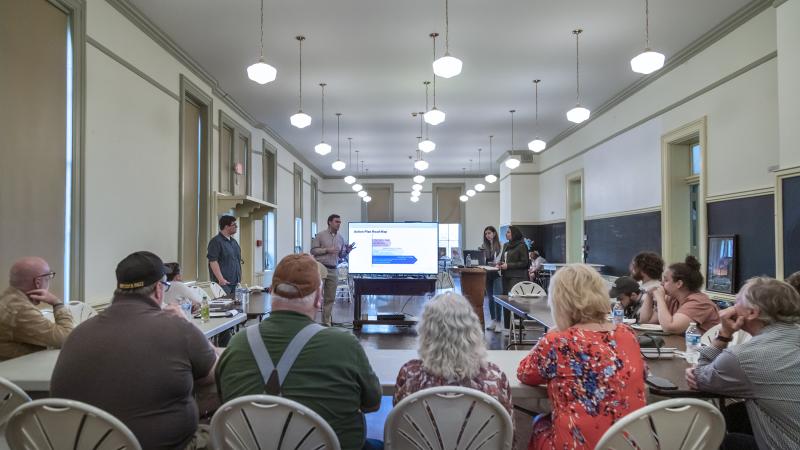Direction Dresden Action Plan: Weaving a Town’s Heritage into a Reimagined Future
When the Longaberger Company closed in 2018, the local economy of Dresden, Ohio, where the company’s handcrafted maple wood baskets were made, quickly unraveled. Nestled in the basin where the Wakatomika Creek flows into the Muskingum River, the town of 1,800 suffered a fiscal crisis of lost jobs and tax revenues. Today, Dresden finds itself at a crossroads: how can this rural community weave its past heritage into a future that revitalizes the town’s identity and infrastructure?
Proposing solutions for the village of Dresden was the focus of Chad Gibson’s 6910 Community Planning Studio. Over spring 2023 semester, Knowlton School graduate planning students conducted research, identified pertinent case studies, and vetted key issues. Visits to Dresden allowed the students to gather critical background information from various stakeholders, and a presentation of their preliminary findings to the client followed in early March.
“Our first recommendation of the action plan was the short-term goal — “Build Capacity,” said Georgia Papakirk, an MCRP student in Gibson’s studio. “Let’s get everyone in the same room. Let’s talk about coordination and formalize connections.”
Gathering business and property owners in a room together for the first time in many years highlighted for those at the meeting that Dresden had the community partners to make a change, but that they were not moving together toward a common goal. “We assumed this was already happening,” said graduate student Brandon Carpenter. “This made us take a step back and start to think about how we can incorporate their engagement into our action plan.”
Following the mid-term presentation, the students refined their efforts based on feedback from the stakeholders. The students traveled back to Dresden in late April to present their Direction Dresden Action Plan at Union Square, a historic building that was once Longaberger University. The students presented their recommendations according to short-term, medium-term, and long-term projects, breaking down interventions into manageable pieces so the community could approach priorities through achievable implementation strategies.
Among the short-term action items discussed, building capacity to make the community more functionally productive was readdressed. Recommendations included increasing staffing, adding a paid full-time grant writer, grant writing volunteers, and a student volunteer.
“When we first met with our clients, Dresden stakeholders had communicated both a lack of finances within the village as well as an interest in pursuing different projects that could spur community revitalization,” said Konner Kelly. “We saw grants as a way to help fund these initiatives.”
The studio created a modified version of the Program Sustainability Assessment Tool developed by the Center for Public Health Systems Science, which village stakeholders could use to ensure that their projects are ready to be grant-funded before they begin the application process. Because community stakeholders had expressed prior financial concerns about funding for a grant writer, the studio invited Jeanette Wierzbicki, Executive Director of Ohio Mid-Eastern Governments Association, to present how her organization can aid their efforts with grant applications and securing funding for large development projects.

Other short-term recommendations included the creation of Direction Dresden Coalition—a unified strategic visioning organization, Dresden Arts Committee, Tree Council and Community Garden, and a passport program. Medium-term action items included improvements of highway signage and billboards pointing tourists to Dresden, updated wayfinding and village branding, and bike connectivity to improve alternative transportation access to Dresden.
Long-term items that generated a great deal of enthusiasm referenced the community’s unique history as the center of one of the largest basket-making companies in the world. Of interest during the early-semester engagement process was a basket museum, which was formally proposed as a new tourist draw to bring people back to Dresden. The studio also leveraged a current Dresden attraction, the world’s largest woven basket, to propose a new plaza space with the relocated basket to serve as the community focal point along Main Street.

The largest structural item recommended was the Maker’s Incubator Space, a 42,200 sq. ft. building that could serve as a new location for Dresden & Company, a local business that specializes in the production of craft baskets and home accessories.
“The Incubator Space blends aesthetics with functionality,” said Tayyiba Kauser, an MCRP student with a background in architecture who designed the facility. “The unique design reflects the fullness of art and the history of basket weaving. From the two-inch raw veneer on the elevation to the zig-zag pattern on the entrance pavilion, every detail of the building showcases the intricate art of basket weaving. With its idyllic location, the facility’s environment adds to its charm and makes it an even more attractive place to visit.”
At the conclusion of the studio’s Direction Dresden Action Plan presentation, James Lepi, co-founder and CEO of Dresden & Company, commented: “If any part of this plan gets done it will be transformational for the community. You have painted an awesome picture. Great job!”


